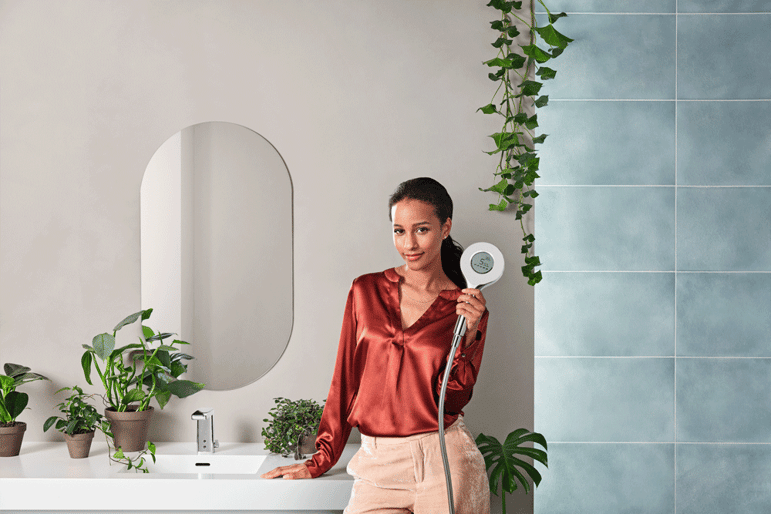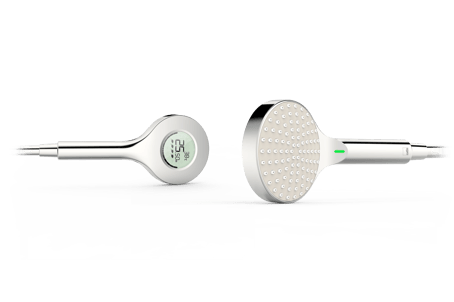For the average household, hot water accounts for a significant share of annual energy consumption - up to half, in fact - and this hot water is used mostly for showers. New research, however, shows that introducing a digital hand shower can reduce household energy consumption by 22% on average.
For example, did you know that using the shower for a minute consumes as much energy as a full day of lighting and home electronics for a three-person household? Or that using the shower for a single second consumes as much energy as a 13-inch MacBook for 1.5 hours?
New research, however, shows that introducing a digital hand shower can reduce household energy consumption by 22% on average.
- In well-insulated houses, the energy consumption for heating water is at the same level as heating, says Kari Lehtinen, CEO of Oras Group.
 Digital hand shower provides real-time feedback about water and energy consumption.
Digital hand shower provides real-time feedback about water and energy consumption.
Saving water is good for the environment
Nobody wants to only have cold showers for the rest of their life (despite their reported health benefits) and so we do need to be able to heat some amount of water. But water is heated mainly using fossil fuels, which makes its carbon footprint relatively high. Reducing energy consumption associated with water therefore helps to decarbonize the planet.
- Saving water and energy has been in the DNA of Oras Group’s product development since the company’s foundation, says Lehtinen.
- Consumers are well-informed and interested in their carbon footprint, he continues. Energy-efficiency and user-friendliness are also considered valuable in renovations and construction. These are two important drivers in Oras Group’s growth and profitable business.
"We have the aim of making our functions carbon neutral by the end of 2023."
Self-motivation fosters behavioral change
Without practical solutions, there’s a wide gap between talking about saving energy and actually doing it. That’s why there needs to be a wider adoption of smart low-carbon solutions that improve the energy efficiency of the average household. But consumers can only reduce their energy consumption after first being aware of their usage.
The best way to boost consumption awareness for consumers is to make it continually and concretely visible to them. Monitoring consumption daily will encourage consumers to be more conscious about their energy use and will also offer significant cost savings.
- When we see our phone, smart watch or heart rate belt show our daily steps, our heart rate, our recovery ability and our quality of sleep, that’s when we start to change our behavior, says Janne Rautavuori, CTO of Oras Group.
“A digital shower has a similar effect. It makes users aware of the amount of water and energy they use in the shower, and that’s when they start saving money.”
What the science says about cost savings?
Universities in Switzerland and Germany have studied how the behavior of hotel guests and households changes when they get immediate information about shower water and energy consumption.
Their research has shown that introducing a digital hand shower offers a significant reduction in both energy usage and costs:
Hotel guest consumption fell by 11.4%
- The study involved six hotels and 265 rooms
- A total of 20,000 shower recordings were studied
- The results were published in Nature Energy as an article (“Real-time feedback promotes energy conservation in the absence of volunteer selection bias and monetary incentives”)
Household energy consumption fell by 22%
- There was a reduction of energy consumption (1.2 kWh per day and household)
A total of 700 households in Zürich were studied
A total of 45,000 shower recordings were studied
The results were published in Management Science as an article (“Overcoming Salience Bias: How Real-Time Feedback Fosters Resource Conservation”)
Carbon emissions decreased by roughly 100 kg per household
The flow and temperature sensors of the hand shower measure consumption and give real-time information. This immediately available information makes it easier and more rational for people to decide to take shorter showers.
Shower “traffic lights” signal consumption
Using a traffic light LED system - green, yellow, and red - a digital hand shower can categorize how much water consumers use in order to make usage easy to understand. The green light displays until 30 liters of usage, the yellow light displays for 30-50 liters of usage, and the red light displays above 50 liters of usage.
These ranges are the factory settings, however, and can be changed.
A digital hand shower’s LCD shows detailed information about water and energy consumption during a shower session, and users can monitor usage over a longer period using a mobile app. The shower system generates the energy it needs from waterflow – which means that batteries are not required – and is suitable for all shower hoses.
Saving hot water will be the next big step in achieving society’s ambitious decarbonization goals.